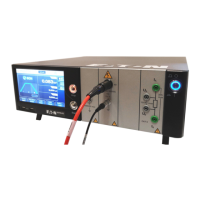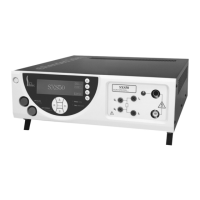User manual SEFELEC 5x Series 178 v1.06
LIST OF RS232C COMMANDS
The syntax of the commands sent on the RS232C connection has been made consistent
with the IEEE488-2 standard (1992 revision).
Reminders of the digital formats according to the IEEE488-2 standard.
NR1 format: +/-<digit>...<digit>
NR2 format: +/-<digit>...<digit>.<digit>...<digit>
NR3 format: +/-<digit>...<digit>.<digit>...<digit>E+/-<digit>..<digit>
Note: The codes in brackets are the expanded codes that can be interpreted by the de-
vice.
18.1.1. GENERAL COMMANDS
REM (REMote) Passage into the remote mode.
WARNING: To be sent before any other command.
For security reasons, this command is only valid during the starting test pattern
(screen displayed at power on).
GTL (GoToLocal) Return to Local mode.
LLO (LocalLockOut) Return to local mode locked.
18.1.2. STANDARDIZED COMMANDS
*SRE <NR1>
(Service Request Enable Register). Enables, according to NR1, the corresponding indi-
cators of the "status byte register" (STB). In this way, the user can select the reasons
for which an SRQ is issued (character Z). See Code *STB?.
*ESE <NR1>
(Standard Event Enable Status). Selects the events bits likely to enable the Overall
Event Indicator (BSE) in the "Event Register" registry. Using these event indicators the
user can control the active events field.

